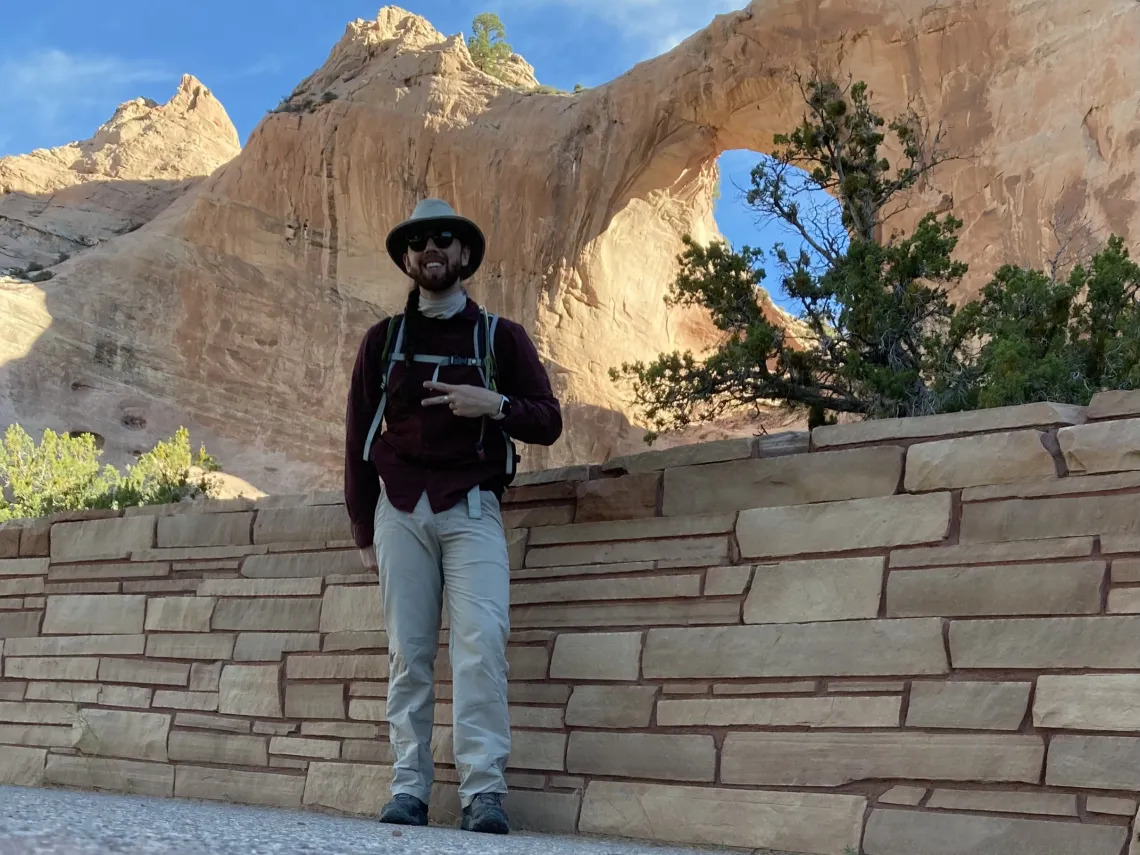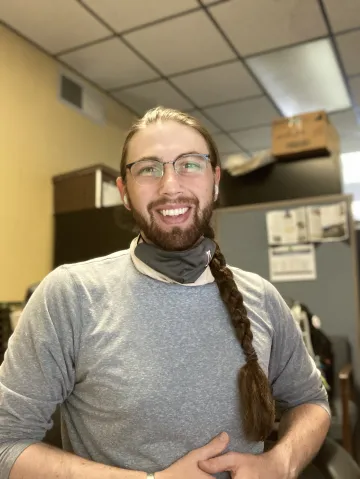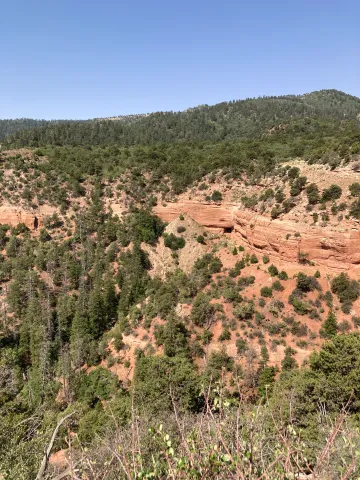Trainee William Borkan Conducts Internship with the Navajo Nation EPA Superfund

William Borkan
William Borkan is an Indige-FEWSS Trainee earning a Master’s Degree in the Department of Environmental Science at the University of Arizona. He works in the Contaminant Transport Lab with Dr. Brusseau and Dr. Araujo, studying uranium transport through fractured rock cores. William served at the Navajo Nation Environmental Protection Agency (EPA) during his Summer 2021 Internship – this is his story.

William Borkan
William’s Internship Experience at the Navajo EPA Superfund
In my “corner office” at the Navajo Superfund office in St. Michaels, Arizona, the fan blows cool air across my back, a welcome relief while hot air settles in and around the office. In the mornings, we wait for the cooler to gather enough water for the entire afternoon. My ten week internship at Navajo Superfund has been punctuated by a variety of tasks, experiences, and personal conversations. My coworkers consist of mostly Diné women, with the exception of my boss and our lead engineer. There is a great amount of respect for the women here, however this is tempered by the treatment they receive by US EPA as well as the Navajo Nation government, who unfairly criticize and beleaguer them for trying to extend protection to vulnerable communities on Diné Bikeyah1.
This work is invigorating and seemingly endless. Of the 523 abandoned uranium mines that are known, only one has reached the point that an engineering evaluation cost analysis (EE/CA) has been drafted. None are fully remediated. Each day, documents are poured over by Navajo Superfund and US EPA staff, comments made, discussions held, and then the potential responsible party (PRP) gets to respond, often agreeing to disagree, sending the discussion back to the start. Some sites are funded by a different mechanism that allows for Navajo Superfund comments to be received with considerably less conflict. I don’t get to work on those sites as my attentions this summer have been focused on the Cyprus/Amax sites in the Lukachukai Mountains near Cove as well as a few sites in the Monument Valley region of Arizona. This work is very important, but to hear my coworkers talk about the resistance that they receive from US EPA and the PRPs is extremely disheartening. They continuously try and advocate for communities dealing with upwards of 80 years of mining, contamination and adverse health effects. My coworkers are working persistently to undo decades of environmental racism through aligning remediation strategies with traditional ecological knowledges and Diné Fundamental Law. These knowledges are bigger than any bilagaana2 could understand, but I try.

William Borkan
William’s Experience Living on the Navajo lands
While I work in St. Michaels, I am lucky to get to spend time with my partner’s family in Chinle. The commute is 64 miles and just about 1 hour each way on the Colorado Plateau. Occasionally, I slow down and stop when a flock of sheep is herded from one side of the road to another. Most days, I see horses graze and stray dogs trot alongside the roadways. I see a lot of carcasses as well, but they eventually get moved off the road. Back in Chinle, my neighbor’s 2-year-old dog has lost weight by caring for her 3rd litter of puppies. The 7 little ones play happily on an oval of patchy grass, which is a remnant of Phoenix suburbs that my neighbor misses. These puppies don’t have a lot of hope in life. The first litter was stricken with parvo; a debilitating disease that lives on in the soil for up to a year. That litter died last winter and I don’t want this litter to go through the same fate. I’ve been patiently asking my neighbor what he wants to do with them as I try hard not to pass judgement or invoke any western ideas about pet responsibility.
This past week, the puppies started getting knocked around by the 7 adult dogs on the property and their mom snaps at them when they try to nurse. I asked my neighbor last week how the pups are doing and he said they are ready to go. I immediately offered to take them to Flagstaff. My partner’s mom and youngest brother help me set up a litter of newspapers and old rugs in the trunk of my car and we set about gathering the puppies. It wasn’t easy to round them up. All of them have been well fed and switched very easily over to dry dog food when mom’s milk ran dry. Five of the puppies come easily when we lure them with bits of hot dog, but two are more cautious. They hide under the deck, ducking away when anyone makes a sudden movement or comes too close. I lay across the deck, waiting for them to pop out to nibble bits of hot dog. They yelp when I grab them, but I assure them they are going to a more forgiving place.
My neighbor’s mom is happy to help me load up the dogs, but I see the pain in her eyes when asking if I’ll take the mother. I tell her that her son refuses to part with her, although she remains un-fixed along with the other 5 adult dogs on the property. As I depart, I tell her that I’ll do what I can for the adults when I get back, but I don’t have a whole lot of hope that my neighbor will do the right thing and I can tell his mother feels the same way.
During their first car ride, the pups whine as we trundle along dirt and old paved roads out of Chinle. As we get going along the first long straightaway, I switch my music over to the audiobook version of Braiding Sweetgrass by Robin Wall Kimmerer. The soothing voice of the author settles down the pups immediately. As we drive, some clamber up the sides of the trunk to sit in front of the little windows, just content to look out the windows watching their home pass by. They stay quiet for the rest of the drive, even through torrential rains. Six of the seven pups are mostly black, but one is brown. My partner calls this one Nimaasi, or potato, in Diné Bizaad. At the shelter, the puppies get new names and I say my goodbyes to Nimaasi, who was easily the friendliest of the bunch, before returning home again.
This story serves to illustrate the divide that has existed on the Navajo Nation for over 100 years now. Before the Long Walk, the Diné people were a matrilineal society. Women dictated the social structure and the local economies to provide for their families. After bilagaanas like my ancestors came into the southwest, these roles were changed. Christianity dictates a woman’s place is in the home and that a man is to provide income through wage work. For a time, the gender and economic roles were slow to adapt to western ways, but mining catalyzed a dramatic shift in the Diné people. These uranium mines provided consistent, decent wages for working men in Diné Bikeyah. Men, already respected over women by Euroamericans, now respected one another over the other genders.
I see the tendrils of this gender dichotomy every day on the Navajo Nation, whether I am at work or at home. My coworkers at Navajo Superfund are almost all women, all of whom have direct ties to these abandoned uranium mines. Some had relatives who worked in them, others lived in the path of the Church Rock spill of 1979. All of them hold their families dear to them, as some of them are cancer survivors themselves. At one time, women were respected as the center of Diné society. Today, they hold three of the twenty-four seats on the tribal council and continue to suffer ridicule and harassment from men and women alike. I respect the women with whom I work. They continue doing the work to protect the people, despite what men – Diné, bilagaana or otherwise – have to say about it.
I am very sensitive of these relationships and they are important to me as my ancestors were part of the reason this legacy exists here in the first place. My mom's great uncle was one of the lead researchers on the Manhattan Project and helped Ernest O. Lawrence build the cyclotron, which is a powerful machine that isolates radioactive isotopes necessary for the production of nuclear fuel. Even though my family doesn’t talk about him by name, I was able to find our ancestral link to his work easily. I know that I am not personally responsible for the cleanup of these abandoned uranium mines, but it is extremely important that I am involved. Although I cannot erase my family’s history and the harm they have caused, I am passionate about honoring the people and the land that they exploited by doing my best to leave Diné Bikeyah better than my ancestors did.
1 Diné Bikeyah translates to “people’s sacred lands” in Navajo language.
2 Bilagaana translates to “White person” in Navajo language.
